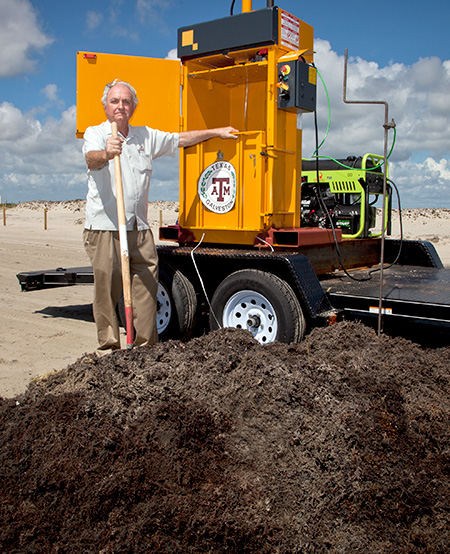Texas A&M Galveston to Host American/French Seaweed Conference
Tweet We all remember the summer of 2014, when the beaches of the Texas coast filled with Sargassum (seaweed) and when moved back from the beach it was piled higher that the Galveston seawall.
We all remember the summer of 2014, when the beaches of the Texas coast filled with Sargassum (seaweed) and when moved back from the beach it was piled higher that the Galveston seawall.
A year ago, the scientific attaché at the General Consulate of France in Houston, visited Texas A&M Galveston. The French Government is interested in collaborating with the university's scientists because the French islands in the Caribbean, specifically Martinique and Guadeloupe, were overwhelmed with landings of Sargassum in 2015 as Galveston was in 2014.
As a result, The French-American Workshop on Sargassum will be held in the Waterfront Pavilion on the campus of Texas A&M Galveston on January 17 through 19. Details and bios of speakers are attached in the agenda.
The workshop will be introduced with a Welcome to Galveston by James D. Yarbrough, mayor of Galveston, former astronaut Colonel Michael E. Fossum, chief operating officer at Texas A&M University at Galveston, and Dr. Minh-Hà Pham, counselor for science and technology at the French Embassy in Washington, DC.
The workshop will gather marine biologists, oceanographers, algologists, physicists, satellite imaging and data and remote sensing scientists from prominent research institutions in France, western Africa and the United States. "By sharing expertise and developing mutual awareness, the workshop aims to foster French-American collaborative research in this field," said Dr. Tom Linton, a former professor at Texas A&M at Galveston, along with Texas A&M Galveston faculty members Dr. Victor Viser, Liberal Studies and Dr. Gil Rowe, Marine Biology, is one of the American developers of the French/American Sargassum Workshop.
It will address several issues of Sargassum: understanding the origins of Sargassum landings in unusual areas, forecasting and modelling the travel routes of Sargassum patches, evaluating the impact of Sargassum overgrowth on marine ecosystems, engineering the collection and the processing of Sargassum and current developments of the Sargassum Early Advisory System (SEAS) developed by scientists at Texas A&M Galveston.
SEAS was created with the help of the National Aeronautics and Space Administration (NASA). At the heart of the SEAS system is satellite imagery provided by NASA's LandSat satellites. It predicts the movement and severity of Caribbean Sargassum landing on Texas beaches thereby providing an early warning system that helps communities and governments prepare in advance to deal with Sargassum landings.
"Since we have determined a means as to how and when Sargassum will arrive, as it did in 2014 on Galveston. The next questions are, why did it not arrive on Galveston from 2015 through 2017 and will it arrive in 2018? Those are the questions we hope to research in cooperation with the French scientists," said Linton.
###